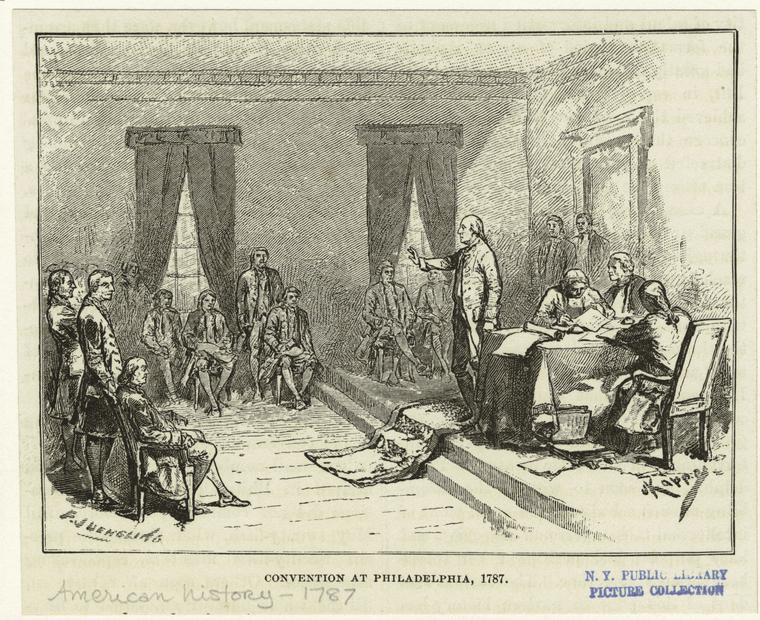Liberty Matters
Response

In light of my colleagues’ excellent essays, most of which emphasize and highlight antislavery voices at the Philadelphia Convention or later antislavery interpretations of the U.S. Constitution, I’d like to highlight the immediate context and challenges facing delegates in 1787. The first is the precariousness of “union.” A confederacy of all 13 states was very much in doubt at the time, and hinged upon the protection of the free movement of people—and their property—in all member states. Second, the Constitution could not reflect the antislavery aspirations of delegates and still attract (or reassure) potential member states—it had to reflect the proslavery present of 1787: the transatlantic trade from Africa to the United States and the existence of slavery in 12 of 13 states. In other words, states’ consent to join the union was contingent upon protections for slavery as it existed in 1787, not as it would exist—or end—in future time.
In 1787, it was by no means certain that a federal union of 13 states would emerge as the outcome. Indeed, many political observers—both in the U.S. and in Europe—predicted that the United States would instead fracture into two or three separate confederacies. Many welcomed this idea. The Boston Independent Chronicle declared that it was “time to form a new and stronger union”—the “five States of New-England.” A French official argued that it would be “impossible to unite under one head all the members of the confederation,” and suggested a Northern, Center, and Southern confederacy instead. An editorial in the New York Daily Advertiser queried whether “instead of attempting one general government for the whole community of the United States, would it not be preferable to distribute the States into three Republics.” South Carolinian David Ramsay declared that “my first wish is union” but “my second wish is to confoederate[sic]” with New England rather than North Carolina, Virginia, and Maryland. Richard Price, the British reformer, was alarmed at the idea of separate confederacies, and urged U.S. lawmakers to establish “some general controuling[sic] power” and “to constitute a union which shall have weight and credit.” Otherwise, European leaders would conclude “that you are falling to pieces, and will soon repent of your independence.”
Before the invention of the cotton gin in 1793, the end of slavery appeared to be on the horizon. Tobacco was on the wane, and some Upper South planters and farmers concluded that wheat might be the new cash crop of choice. It seemed plausible that many areas of the post-Revolutionary South could function without slavery, leading some to forecast the institution’s decline and eventual abolition. But even if they imagined an antislavery future for the United States, the reality of slavery that delegates faced in 1787 was far different. Transatlantic slaving was only accelerating at the time. Between 1783 and 1787, slave ships brought a staggering 8,041 African captives into three main U.S. ports—Charleston, Savannah, and Beaufort. Many of these slaving voyages began not in Britain or South Carolina, but rather in Rhode Island. And according to the first U.S. census taken in 1790, enslaved people were recorded in every state save Massachusetts. Vermont claimed the fewest slaves—a mere 16—while Virginia held the highest enslaved population, at 292,627. Meanwhile, South Carolina contained the largest percentage of enslaved people within its borders, at 43 percent. Therefore, “union” would have to offer protections to slaveholders as well as merchants involved in the slave trade—not just in the South, but in the majority of the states in 1787.
Citations:
1. The Documentary History of the Ratification of the Constitution Digital Edition, ed. John P. Kaminski, Gaspare J. Saladino, Richard Leffler, Charles H. Schoenleber and Margaret A. Hogan. Charlottesville: University of Virginia Press, 2009.
2. U.S. Federal Census, 1790.
3. Trans-Atlantic Slave Trade Database, slavevoyages.org.
Copyright and Fair Use Statement
“Liberty Matters” is the copyright of Liberty Fund, Inc. This material is put on line to further the educational goals of Liberty Fund, Inc. These essays and responses may be quoted and otherwise used under “fair use” provisions for educational and academic purposes. To reprint these essays in course booklets requires the prior permission of Liberty Fund, Inc. Please contact oll@libertyfund.org if you have any questions.